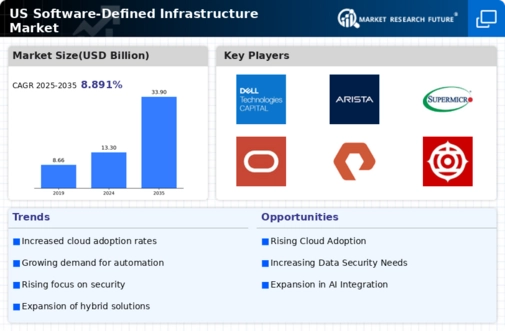Rising Demand for Scalability
The software defined-infrastructure market is experiencing a notable surge in demand for scalability solutions. Organizations are increasingly seeking infrastructure that can dynamically adjust to fluctuating workloads. This trend is driven by the need for businesses to remain agile in a competitive landscape. According to recent data, approximately 70% of enterprises in the US are prioritizing scalable solutions to enhance operational efficiency. As a result, vendors are focusing on developing software defined-infrastructure that can seamlessly integrate with existing systems while providing the flexibility to scale resources up or down as needed. This adaptability is crucial for organizations aiming to optimize their IT investments and respond swiftly to market changes.
Growing Focus on Sustainability
Sustainability is becoming an increasingly important consideration in the software defined-infrastructure market. Organizations are recognizing the need to reduce their carbon footprint and enhance energy efficiency. This shift is prompting businesses to adopt infrastructure solutions that align with sustainability goals. Recent surveys indicate that over 60% of US companies are prioritizing eco-friendly practices in their IT strategies. By implementing software defined-infrastructure, organizations can optimize energy consumption and reduce waste, contributing to their overall sustainability objectives. This focus on environmental responsibility is likely to drive innovation and investment in sustainable infrastructure solutions, further shaping the software defined-infrastructure market.
Enhanced Data Management Capabilities
The demand for enhanced data management capabilities is a significant driver in the software defined-infrastructure market. As organizations generate and process vast amounts of data, the need for efficient data management solutions becomes paramount. Software defined-infrastructure offers advanced data storage, retrieval, and processing capabilities, enabling businesses to harness the full potential of their data assets. Current trends indicate that approximately 75% of enterprises in the US are investing in data management solutions to improve decision-making and operational efficiency. This emphasis on data-driven strategies is likely to propel the growth of the software defined-infrastructure market, as organizations seek to leverage their data for competitive advantage.
Integration of Artificial Intelligence
The integration of artificial intelligence (AI) into the software defined-infrastructure market is emerging as a transformative driver. AI technologies are being utilized to enhance automation, predictive analytics, and decision-making processes within infrastructure management. This integration allows organizations to proactively address potential issues and optimize performance. As AI capabilities continue to evolve, the software defined-infrastructure market is likely to witness increased adoption of AI-driven solutions. Reports suggest that by 2026, AI-enhanced infrastructure management could lead to a 25% improvement in operational efficiency for organizations. This potential for enhanced performance positions AI as a key factor in shaping the future of the software defined-infrastructure market.
Cost Efficiency through Resource Optimization
Cost efficiency remains a pivotal driver in the software defined-infrastructure market. Organizations are increasingly recognizing the financial benefits of optimizing their IT resources. By leveraging software defined-infrastructure, companies can reduce hardware expenditures and operational costs. Recent statistics indicate that businesses utilizing these solutions have reported up to a 30% reduction in total cost of ownership. This financial incentive is compelling, as organizations strive to allocate their budgets more effectively. Furthermore, the ability to automate resource allocation and management contributes to ongoing cost savings, making software defined-infrastructure an attractive option for enterprises looking to enhance their bottom line.

















Leave a Comment